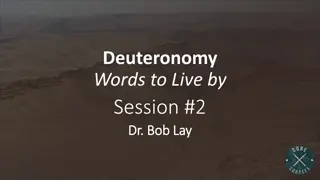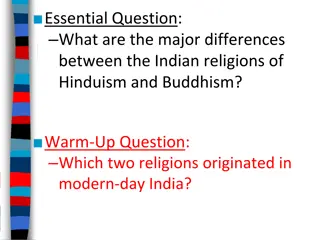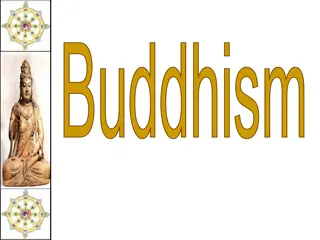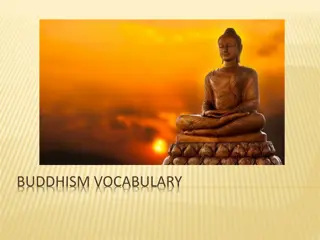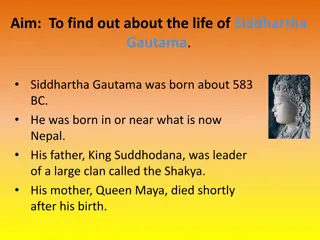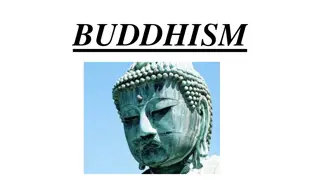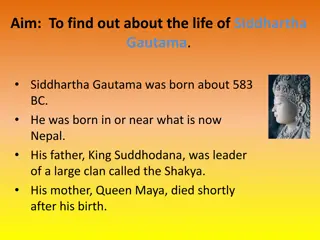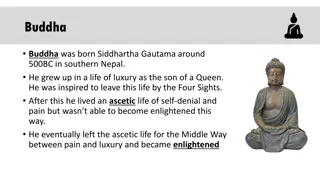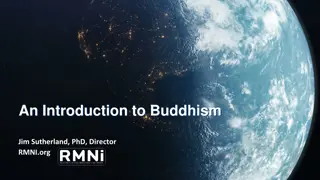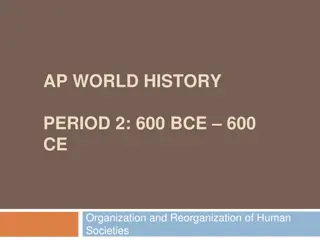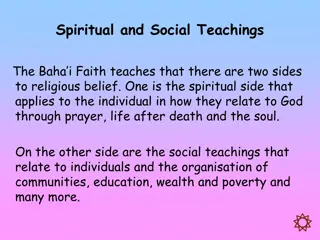Siddhartha and Gotama's Teachings
Embark on a journey of self-discovery and enlightenment through the contrasting philosophies of Siddhartha and Gotama. Reflect on essential questions about uniqueness, awakening, and equanimity, while delving into the historical context of Buddhism. Discover the profound teachings and individual paths of these two iconic figures as they navigate the complexities of life and spirituality.
Download Presentation

Please find below an Image/Link to download the presentation.
The content on the website is provided AS IS for your information and personal use only. It may not be sold, licensed, or shared on other websites without obtaining consent from the author.If you encounter any issues during the download, it is possible that the publisher has removed the file from their server.
You are allowed to download the files provided on this website for personal or commercial use, subject to the condition that they are used lawfully. All files are the property of their respective owners.
The content on the website is provided AS IS for your information and personal use only. It may not be sold, licensed, or shared on other websites without obtaining consent from the author.
E N D
Presentation Transcript
SIDDHARTHA Day 4
GOTAMA: ESSENTIAL QUESTIONS If you want to be truly unique, do you truly belong somewhere? What is the difference between what teachers teach us and what we must learn on our own? Is it natural to want to imitate or be unique?
AWAKENING: ESSENTIAL QUESTIONS Are feelings real? How do they lead to tangible outcomes? After a major realization (or awakening) we usually feel stupid. What was presenting us from seeing the truth prior to the realization? Is it possible to look only to the future, no longer look backwards?
VOCABULARY Equanimity (n) = remaining calm whilst under pressure. We saw this word in The Importance of Being Earnest! Make sure I get your vocabulary word input.
WARM-UP Make a list of ten things you know (with 100% certainty) about yourself. Make a list of ten things that remind you that you re growing up positive (getting license!) or negative (aching bones!).
THE HISTORICAL BUDDHA Take a look at the fact half-sheet and the back of the handout. There are facts about Buddhism and the historical Buddha. Complete the handout with a partner. While you re answering the two questions on the bottom, keep these three things in mind: This novel was written just after WWI. It s more than an explanation of Indian philosophy. It s autobiographical of Hesse.
GOTAMA AND SIDDHARTHA Gotama Siddhartha Went on quest for enlightenment. Adopted Indian Asceticism. Born into a leader s family Is called Siddhartha and the Awakened One. Does not believe in a personal God. Teaches the Four Noble Truths and that life is pain. Called the Enlightened One. Wanted to solve suffering for all humans. Attained Nirvana
TWO DIFFERENT CHARACTERS? Why do you think Why do you think Hesse names, actions, and beliefs relate to the historical figure of names, actions, and beliefs relate to the historical figure of the Buddha? the Buddha? Clearly the difference between Gotama and Siddhartha is important. They are not the same, but they exist at the same moment in time. Siddhartha is truly on his own. He does not want or need followers. His goal is to achieve peace for himself. Siddhartha s way is his own not Govinda s, not the Buddha s, not even Hesse s. Perhaps Hesse needed to restore peace to his world and belief in humanity after the turmoil of WWI. Hesse sorts things out through Siddhartha? Hesse chose to create two characters whose chose to create two characters whose
TIME AND PLACE? Why did Hesse not include a clear reference to a particular time period or geographical region? He wanted to created a legendary or magical world. Hesse didn t want readers to be terribly concerned with trying to figure out the truth about actual events. It s not an explanation of Indian philosophy. But by placing Siddhartha in ancient India with the Buddha, he creates a timeless, mythic validity. The legendary times allow the reader to lose the sense of differentiation and to come nearer to the oneness of the human race. The parallels to the Buddha s life contribute to the legendary quality, too.
PREDICTIONS Where is Siddhartha headed next? Let s continue reading and we shall see! Homework Homework: finish chapters called Kamala and Amongst the People. Presentations?



